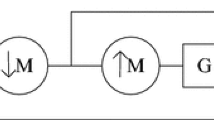Abstract
Genetic algorithm (GA) based on wavelet transform threshold shrinkage (WTS) and translation-invariant threshold shrinkage (TIS) is introduced into the method of noise reduction, where parameters used in WTS and TIS, such as wavelet function, decomposition levels, hard or soft threshold and threshold can be selected automatically. This paper ends by comparing two noise reduction methods on the basis of their denoising performances, computation time, etc. The effectiveness of these methods introduced in this paper is validated by the results of analysis of the simulated and real signals.
Similar content being viewed by others
References
Chang, C.S., Jin, J., Kumar, S., Su, Q., Hoshino, T., Hanai, M., Kobayashi, N., 2005. Denoising of partial discharge signals in wavelet packets domain. IEE Proceedings of Science, Measurement and Technology, 152(3):129–140. [doi:10.1049/ip-smt:20041315]
Donoho, D.L., 1995. De-noise by soft-thresholding. IEEE Trans. on Information Theory, 41(3):613–627. [doi:10.1109/18.382009]
Hsung, T.C., Lun, D.P.K., Ho, K.C., 2005. Optimizing the multiwavelet shrinkage denoising. IEEE Trans. on Signal Processing, 53(1):240–251. [doi:10.1109/TSP.2004.838927]
Jack, L.B., Nandi, A.K., 2002. Fault detection using support vector machines and artificial neural networks augmented by genetic algorithms. Mechanical Systems and Signal Processing, 16(2–3):373–390. [doi:10.1006/mssp.2001.1454]
Mallat, S.A., 1989. A theory for multi-resolution signal decompositions: the wavelet representation. IEEE Trans. on Pattern Analysis and Machine Intelligence, 11(7):674–693. [doi:10.1109/34.192463]
Mallat, S.A., 2002. A Wavelet Tour of Signal Processing, Translated by Yang, L.H., Dai, D.Q. China Machine Press, Beijing, p.122–165 (in Chinese).
Sun, Y.K., 1998. Wavelet Transform and its Applications. China Machine Press, Beijing, p.219–244 (in Chinese).
Taswell, C., 2000. The what, how, and why of wavelet shrinkage denoising. IEEE Computational Science and Engineering, 3(2):12–19.
Tu, K., Jiang, Y.Y., 2004. Development of Noise Reduction Algorithm for Underwater Signals. IEEE International Symposium on Underwater Technology, p.175–179.
Xiao, M.H., Xue, J.Y., 2003. Research and application of genetic algorithm theory. Computer Engineering, 29(20):137–139 (in Chinese).
Xu, Y., Weaver, J.B., Healy, D.M., Lu, J., 1994. Wavelet transform domain filters: a spatially selective noise filtration technique. IEEE Trans. on Image Processing, 3(6):747–758. [doi:10.1109/83.336245]
Yang, X.J., Zheng, J.L., 2003. Artificial Neural Network and Blind Signal Processing. Tsinghua Press, Beijing, p.301–324 (in Chinese).
Author information
Authors and Affiliations
Additional information
Project (No. 51446020203JW0401) supported by the State Key Laboratory of Oceanic Acoustics Foundation, China
Rights and permissions
About this article
Cite this article
Ma, Qm., Wang, Xy. & Du, Sp. Method and application of wavelet shrinkage denoising based on genetic algorithm. J. Zhejiang Univ. - Sci. A 7, 361–367 (2006). https://doi.org/10.1631/jzus.2006.A0361
Received:
Accepted:
Published:
Issue Date:
DOI: https://doi.org/10.1631/jzus.2006.A0361




